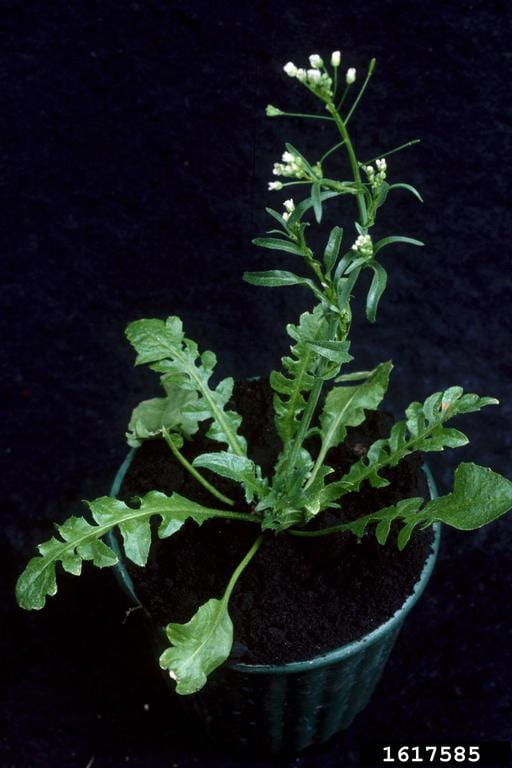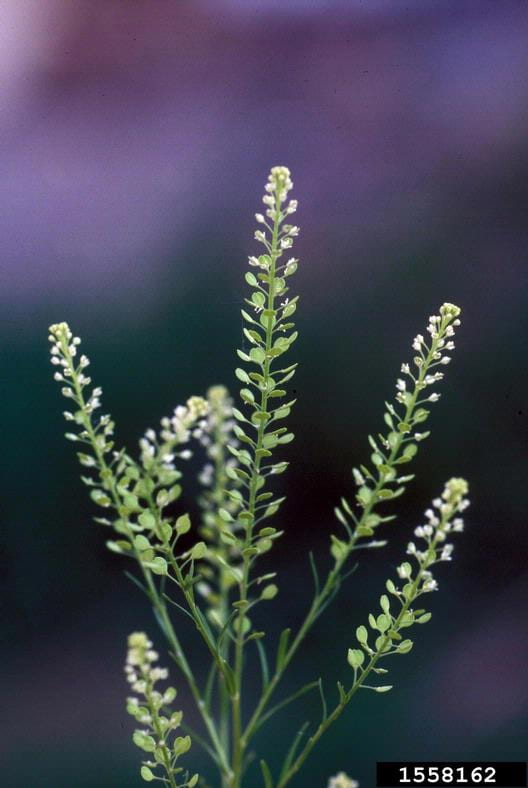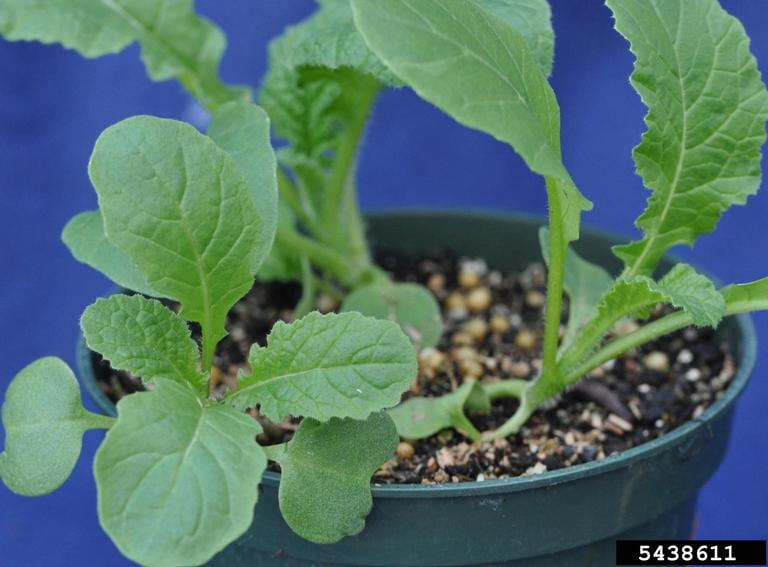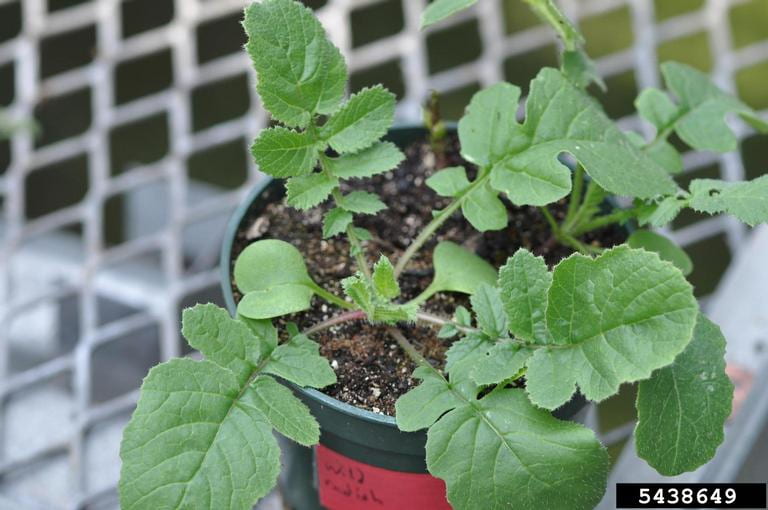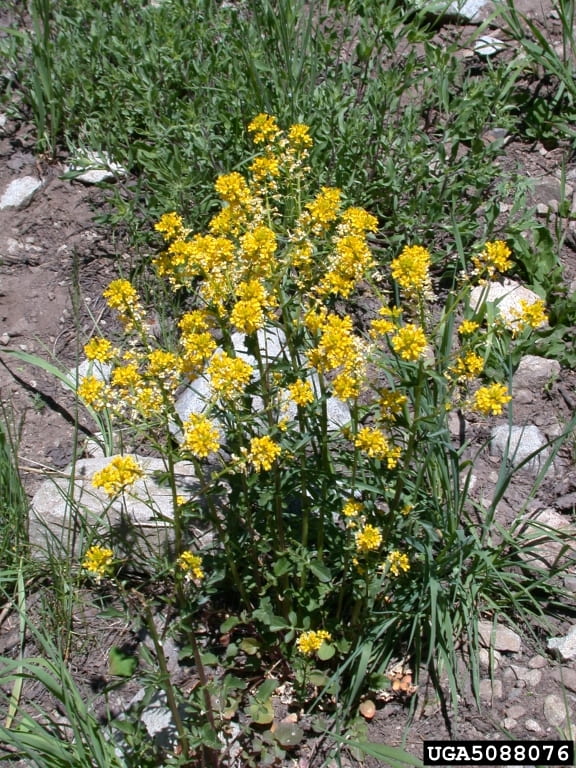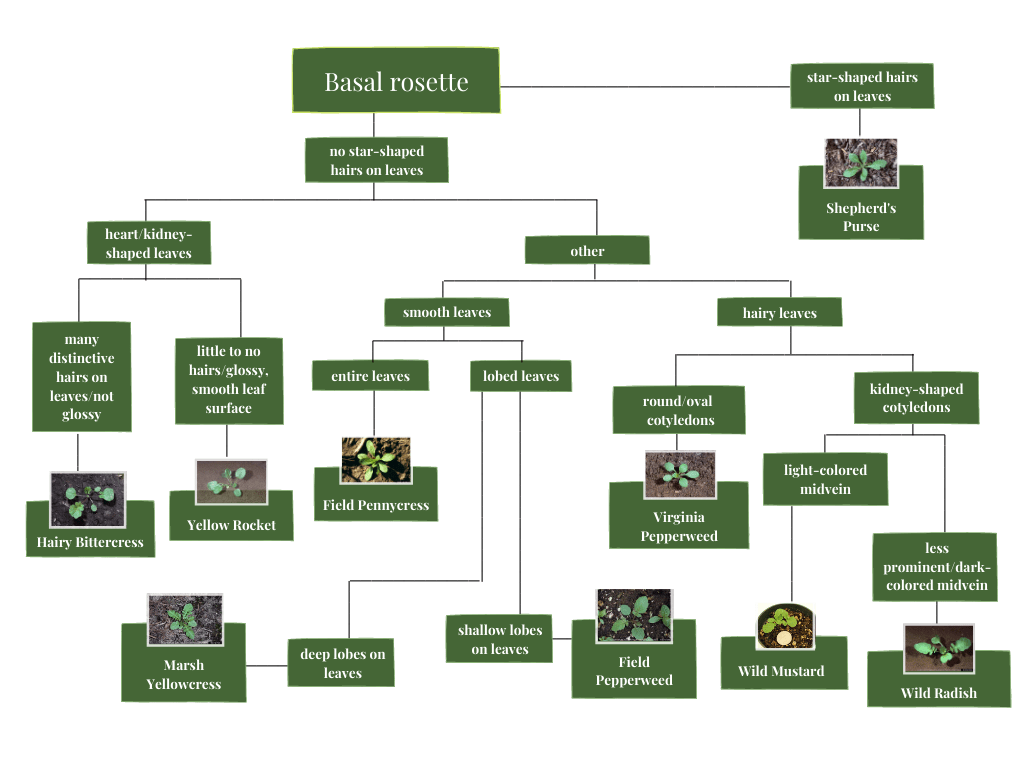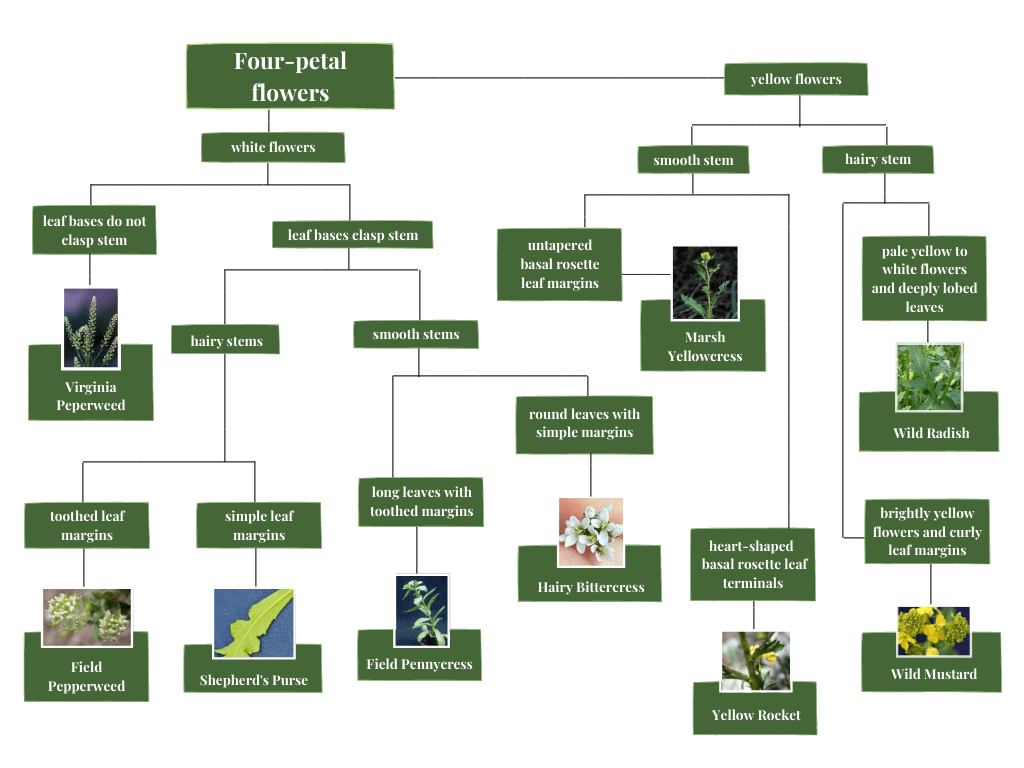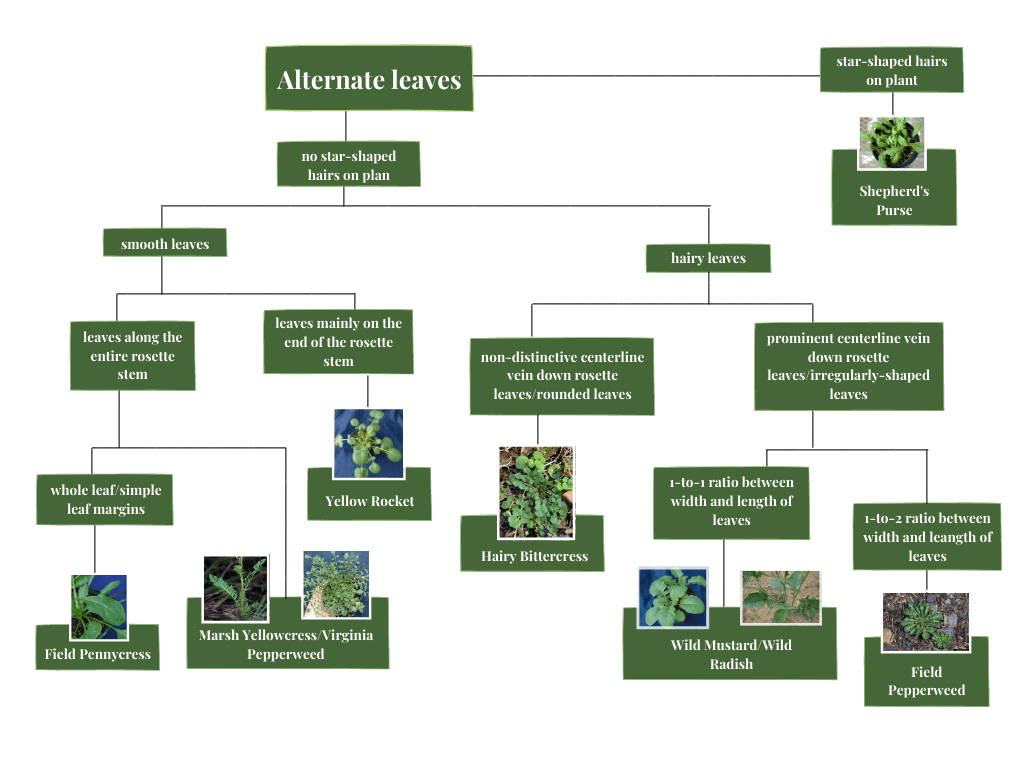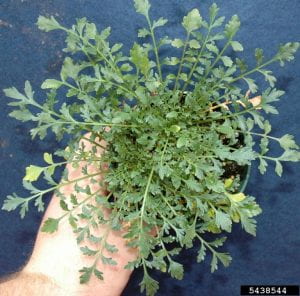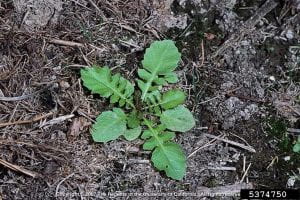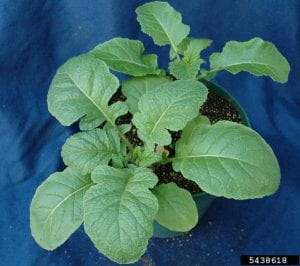Distinguishing New York Mustard Weed Species
The mustard (Brassicacaea) plant family includes vegetables such as broccoli, cauliflower, and cabbage as well as several common New York weeds. The weedy mustards that form spring rosettes can be hard to identify, as they have similar forms and features. Not all mustard weeds are controlled with the same tactics, though, so identification can be important; for example, soybean growers need to be able to distinguish wild mustard from the similar species yellow rocket and wild radish, as wild mustard is not controlled by Butyrac 200, a common 2,4-D herbicide.
To distinguish mustards from other plants, look for mustardy or peppery odors, four petals arranged in a cross shape, and flowers/fruit spirally arranged on a stalk. To tell the mustards apart from each other, look at leaves (early and mature), stems, and flowers. The charts and dichotomous keys on this page can be used at different growth stages of mustard weeds to help identify your weed and point you towards management resources.
This page covers the six species listed below. We have developed three separate sets of identification tools: one for emerging seedlings, one for established rosettes, and one for flowering plants. Look below for the section that fits your needs. In each section, the identification tool is shown both as a decision tree graphic and as a traditional key.
Profiles of featured mustard weeds
Seedlings
Identification chart for seedlings
Identification table for seedlings
1a. Star-shaped hairs on young leaves……..…………………………………….Shepherd’s Purse
1b. No star-shaped hairs on young leaves……..……………………………………………………….2
2a. Heart/kidney-shaped early leaves………….………………….………….…………………………3
2b. Other…………..…………………………………………….………….……..………………………………4
3a. Many distinctive hairs on leaves/not glossy leaves…………….………Hairy Bittercress
3b. Little to no hairs/glossy, smooth leaf surface…………….…………….……Yellow Rocket
4a. Smooth leaves…….…………………………………………………………………………………………5
4b. Hairy leaves……………………………………………………..……………………………………………7
5a. Entire young leaves/simple leaf margins…………………………………..Field Pennycress
5b. Lobed young leaves…………………..……………………………………………………………………6
6a. Deep lobes on leaves………..……………………………………….………….Marsh Yellowcress
6b. Shallow lobes on leaves…..………………………………………………..……Field Pepperweed
7a. Round/oval cotyledons…..…………………….……………………………Virginia Pepperweed
7b. Kidney-shaped cotyledons.…………………….……………………..…..……………………………8
8a. Light-colored midvein….……….……………………………………………………..Wild Mustard
8b. Less prominent/dark-colored midvein.……………………………………………Wild Radish
**Wild mustard and wild radish are very similar in appearance, especially in the seedling stage. If the given descriptions are not able to clearly identify the plant in question, please use photos provided for each plant on their species profiles to make helpful comparisons. You may need to wait 1-2 weeks for the plants to develop more characteristic features.
Butyrac 200 does not control wild radish, which is why its identification is important in some crops. Approaches for non-chemical treatment will be similar for both species.
Mature Plants With Flowers
Identification chart for flowering plants
Identification table for flowering plants
1a. Flowers are white…………………………………………………..……………………………………………….2
1b. Flowers are yellow……………………………………………..……………………………………………………6
2a. Leaf bases clasp the stem…………………………………………………………………………………………3
2b. Leaf bases do not clasp the stem……………………….…………………………Virginia Pepperweed
3a. Stem is hairy…………………………………………………………….……………………………………………4
3b. Stem is smooth…………………………………………………….………………………………………………..5
4a. Toothed leaf margins………………………………………….………………………….Field Pepperweed
4b. Simple leaf margins…………………………………………………….………………….Shepherd’s Purse
5a. Long leaves with toothed margins…….……………………………………………….Field Pennycress
5b. Round leaves with simple margins…………………………….……………………..Hairy Bittercress
6a. Stem is smooth……………………………………………………………………………………………………..7
6b. Stem is hairy………………………………………..……………………………………………………………….8
7a. Basal rosette leaf terminals are heart-shaped..……………………………………….Yellow Rocket
7b. Basal rosette leaf terminals are untapered…….………………..………………Marsh Yellowcress
8a. Bright yellow flowers and curly leaf margins………………………………………….Wild Mustard
8b. Pale yellow to white flowers and deeply lobed leaves……..………………………….Wild Radish
Mature Plants Without Flowers
Identification chart for mature plants without flowers
Identification table for mature plants without flowers
a. Star-shaped hairs on plant……………………………………………………………….Shepherd’s Purse
1b. No star-shaped hairs on plant…………………………………………………………………………………2
2a. Smooth leaves………………………………………………………………………………………………………..3
2b. Hairy leaves…………………………………………………………………………………………………………..5
3a. Leaves mainly on the end of the rosette stem…………………………………………Yellow Rocket
3b. Leaves along the entire rosette stem………………………………………………………………………..4
4a. Whole leaf/simple leaf margins…………….……………..…………………………..Field Pennycress
4b. Leaf with distinct lobes…………………………………Virginia Pepperweed/Marsh Yellowcress
Viriginia pepperweed Marsh yellowcress
5a. Prominent midvein down rosette leaves/irregularly-shaped leaves..…………………6
5b. Non-distinctive midvein down rosette leaves/rounded leaves……….Hairy Bittercress
6a. 1-to-1 ratio between width and length of leaves……………………Wild Radish/Wild Mustard
Wild mustard Wild radish
6b. 2-to-1 ratio between width and length of leaves…………….……………………….………Field Pepperweed
**Please note and understand that a few mustard plants are physically very similar in appearance and are, during certain life stages, hard to distinguish. If the given descriptions are not able to clearly and definitively guide the identification of the plant in question, please use photos provided for each plant (linked at the top of this page) to make helpful comparisons. Alternatively, wait 1-2 weeks for flowers to emerge for more substantial physical characteristics to help with identification.
Butyrac 200 does not control wild radish, which is why its identification is important in some crops.
Mustard Management
Once you identify your species, look at the weed’s species profile (listed towards the top of the page and also linked in identification tables) for management recommendations. Common forms of weed management for the mustard species featured on this page are herbicide application for conventional farms and tillage/cultivation/burial while plants are in the seedling stage on organic farms. For home gardeners or other small scale management scenarios, hand pulling is a good option.
References
Uva R H, Neal J C, DiTomaso J M. 1997. Weeds of the Northeast. Book published by Cornell University, Ithaca NY. The go-to for weed ID in the Northeast; look for a new edition sometime in 2019.
Cornell University’s Turfgrass and Landscape Weed ID app. Identification and control options for weeds common to turf, agriculture, and gardens in New York; uses a very simple decision tree to identify your weed.
UC Statewide Integrated Pest Management Program’s webpage on mustards. Offers general characteristics of mustards in accordance to different stages of plant growth.
A Mustard Identification Workshop by Tim Miller of the Washington State University via the Weed Conference. Document on mustard identification with dichotomous key.
University of Missouri’s Integrated Pest Management webpage. Identification information and images for field pennycress.
Hairy bittercress identification and management information webpage from University of Maryland’s Home and Garden Information Center.
Pennsylvania State University Extension’s webpage on hairy bittercress identification and management information.
Michigan State University Extension’s germination and spreading information on hairy bittercress.
Brooklyn Botanic Garden’s Weed of the Month profile on hairy bittercress.
PennState Extension’s webpage on Control of Summer Annual Grass Weeds in Turfgrasses. Offers descriptions of cultural and chemical control methods.
A Mustard Identification Workshop by Tim Miller of Washington State University via the Washington State Weed Conference. Identification page for mustards.
University of California, Davis’s Weed Report from Weed Control in Natural Areas in the Western United States. Identification and management information on wild radish.
University of California, Davis’s Weed Report from Weed Control in Natural Areas in the Western United States. Identification and management descriptions for yellow rocket.
A Mustard Identification Workshop page by Tim Miller for the Washington State Weed Conference. Identification information on mustard weeds.
Pennsylvania State University’s PlantVillage profile on mustards. Provides a general introduction to and propagation information on mustards.
Lyon D, Burke I, Campbell J. Integrated Management of Mustard Species in Wheat Porduction Systems. A Pacific Northwest Extension Publication from a collaboration between Washington State University, Oregon State University, and University of Idaho.
University of Nebraska-Lincoln’s Institute of Agriculture and Natural Resources’ page on Controlling Winter Annual Weeds. Lays out the problems with winter annual weeds and some information on how to control them.





